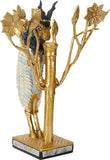DISC-RAM IN THICKET, C/8
Product #:Ram in the Thicket
Penn Museum Object #30-12-702
Early Mesopotamian
Penn Museum Object #30-12-702
Early Mesopotamian
No excavation in Iraq (ancient Mesopotamia) has attracted as much public attention as Sir Leonard Woolley’s work, sponsored by the British Museum and Penn Museum, at the site of ancient Ur, Abraham’s birthplace (Genesis 12: 4-5), in the 1920-30s. And, none of Woolley’s discoveries got more intense coverage than the Royal Cemetery, a graveyard whose 2,000 burials included the tombs of the kings and queens who ruled Ur ca. 2500 BCE. Ur’s royal tombs yielded a wealth of artifacts made of gold, silver, rare stones, shell, etc., and surprising evidence for the execution and interment of court attendants in royal burials.
The many unique artifacts from Ur’s royal tombs showcasing early Mesopotamian artistic traditions included this statuette of a goat nibbling the leaves of a tree, a common sight in the region today. Woolley, in an allusion to Abraham’s sacrifice of Isaac (Gen. 22:13), dubbed the statuette the “ram caught in a thicket.” It is one of two nearly identical statuettes, the other in the British Museum, from the Great Death Pit (PG 1237), a tomb with a royal woman and more than 70 attendants, including musicians. The statuette, originally topped by a tray, served as a support for a cup or bowl. The wooden core of the statuette had decayed in the ground, leaving intact its gold and silver sheeting, as well as shell, lapis lazuli, and limestone inlays. Woolley stabilized the remains with hot wax and strips of cloth before lifting them and later restoring them to nearly pristine condition.
© Penn Museum, University of Pennsylvania Museum of Archaeology and Anthropology.
Made of cold cast resin. Hand painted.
L: 6" x W: 3" x H: 7"



